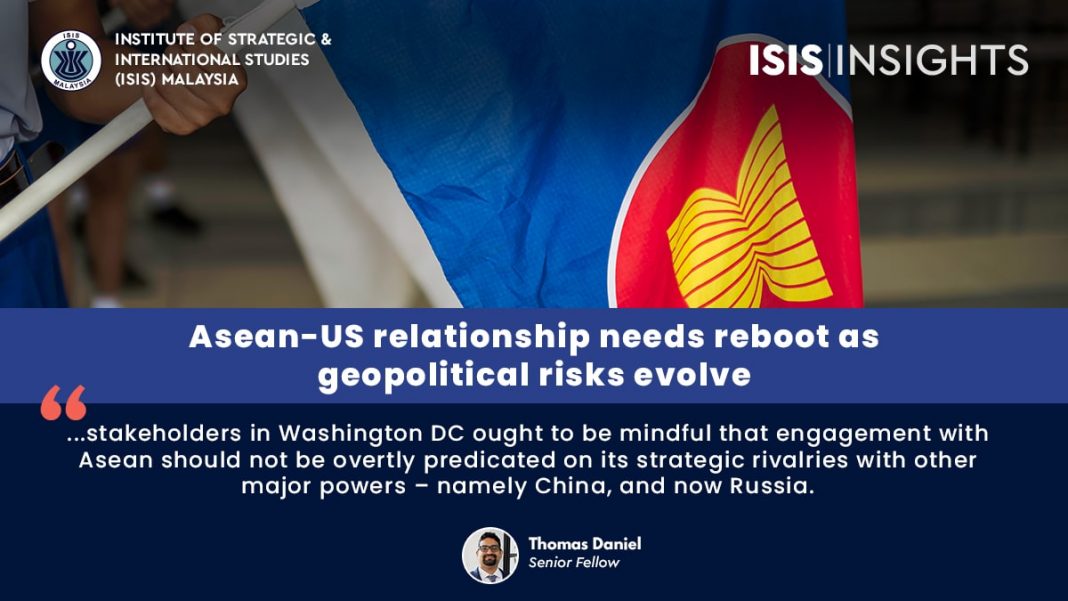Summit on May 12-13 chance to advance regional prospects, minimise stagnation
THE lead up to the much-anticipated Asean-United States (US) special summit did not get off to the best of starts. Last-minute delays because of conflicting schedules saw the summit being postponed in March, before being finally locked in from 12-13 May.
Not all Asean members will be there. Myanmar, to no one’s surprise, has been excluded by mutual agreement while President Rodrigo Duterte of the Philippines has opted to skip the summit to avoid committing to decisions that might bind his successor.
The general sense is that missteps by both sides contributed to the delay. From Asean, there were overlapping and conflicting roles played by Cambodia (the current chair) and Indonesia (coordinator for the US). However, more than a few Asean member states felt that the lack of nuance in the initial planning from Washington did not help matters either.
The Asean-US relationship is an important one, with 2022 marking the 45th anniversary of engagements between the two. It is currently framed as a strategic partnership.
After the myopia of the Trump administration – which many Southeast Asian observers keep bringing up, indicating the lingering trauma – there appears to be traction and focus from the Biden administration in its outreach to Southeast Asia. Securing buy-in from member states is a key element of its Indo-Pacific strategic outreach. Collectively, this region also features prominently in the US supply chain and is one of its largest export markets.
For Asean, the US is its second largest trading partner, with and foreign direct investment touching US$338 billion (RM1.47 trillion) in recent years. This is more than one third of America’s’ total investment in the entire Indo-Pacific region.
The following four issues bear some consideration in the lead–up to the special summit.
First, stakeholders in Washington DC ought to be mindful that engagement with Asean should not be overtly predicated on its strategic rivalries with other major powers – namely China, and now Russia. It will be unrealistic not to expect at least some of this rhetoric coming from the US. But it should not be the substantiative crux of discussions. For most member states, their positions on both China and Russia are unlikely to change, even if there are disputes or reservations. An appreciation of national interests works both ways.
This broader point is almost stale – repeated by many Southeast Asians for many years. Yet the fact that it is a recurrent theme is a damning if not disappointing indictment that despite constant narratives from Washington about how it maintains an “enduring commitment” to Southeast Asia, policymakers there still fail to understand or fully appreciate this region’s concerns and geostrategic realities.
Second, the above is an important lens which the Biden administration’s Indo-Pacific Economic Framework (IPEF) will be perceived among Asean stakeholders. While the broad emphasis of IPEF has been announced – four pillars centred on (1) fair trade, (2) supply chain resiliency, (3) infrastructure, clean energy and decarbonisation; and (4) good governance – President Joe Biden will unveil further details at the special summit.
It would be easier for Asean to get behind IPEF if it were truly open and inclusive, where all member states are engaged and it doesn’t explicitly exclude China’s participation. Also important is the need for signals emphasising the continuity and durability of IPEF as part of long-term US engagement with the region.
Third, it is important to elevate that the Asean-US relationship to that of a comprehensive strategic partnership. The symbolism is an important one and Asean already has such levels of partnership with both China and Australia. The US is well positioned to make it a trio, which will be welcomed by most member states as it seeks equilibrium in its relationships with major powers.
The Asean-United States Strategic Partnership (2021-2025) plan of action provides the economic, political-security and socio-cultural initiatives that can be leveraged on to upgrade the relationship. Initiatives from the US announced in October 2021 focusing on healthcare, climate action and sustainable development initiatives are important building blocks. Policymakers from Asean member states and the US should work towards committing to this elevation by 2025 at the latest.
Last, it isn’t a deterioration of the Asean-US relationship that is the real concern here. Rather it is risk of stagnation or the lack of progress. And there are teething signs that the relationship is not moving as well as it could. Both Southeast Asia and the US ought to keep in mind that “more of the same” or “good enough” is not yardstick either party should aspire for.
It might be a bit late in the game now, but as policymakers and their advisers go into the summit, it would be well worth thinking of the long-term costs that it can inflict on the multilateral relationship.
This is why tangible and demonstrable progress and growth is essential, both for Asean and the US.
This article was also published as “The real concern is the risk of stagnation in Asean-US ties” in New Straits Times on 7 May 2022.





